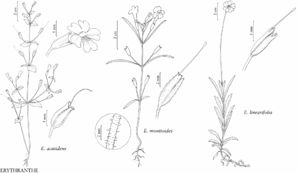Erythranthe montioides
Phytoneuron 2012-39: 35. 2012.
Annuals, taprooted. Stems erect, simple or branched from basal nodes, 2–15 cm, glabrous or minutely puberulent, internodes elongate, distinct. Leaves cauline, basal not persistent; petiole 0 mm; blade 1-veined or palmately 3-veined (in broader ones), linear to lanceolate, (3–) 4–25 × 0.5–2 mm, base attenuate, margins entire, apex acute, surfaces glabrous or minutely puberulent. Flowers herkogamous, 1–6, from medial to distal nodes. Fruiting pedicels (4–) 5–20 mm. Fruiting calyces becoming straw colored, campanulate, 5–7 mm, margins distinctly toothed or lobed, ciliate, glabrous or minutely puberulent, ribs weak, lobes pronounced, erect. Corollas yellow, abaxial limb red-spotted, bilaterally symmetric, strongly bilabiate; tube-throat cylindric to funnelform, 6–10 mm, exserted beyond calyx margin; limb expanded 5–12 mm, lateral lobes entire or shallowly notched, palate glabrous or sparsely bearded. Styles glabrous. Anthers included, glabrous. Capsules included, 5–6 mm.
Phenology: Flowering Jun–Aug.
Habitat: Sandy opening in mixed coniferous and lodgepole forests.
Elevation: 1900–2900 m.
Discussion
Erythranthe montioides has been previously treated as a highly polymorphic species with a relatively broad geographic range but is now recognized as narrowly endemic to Fresno and north-central Tulare counties. The following species were segregated from E. montioides: E. barbata, E. calcicola, E. carsonensis, and E. discolor.
Selected References
None.
